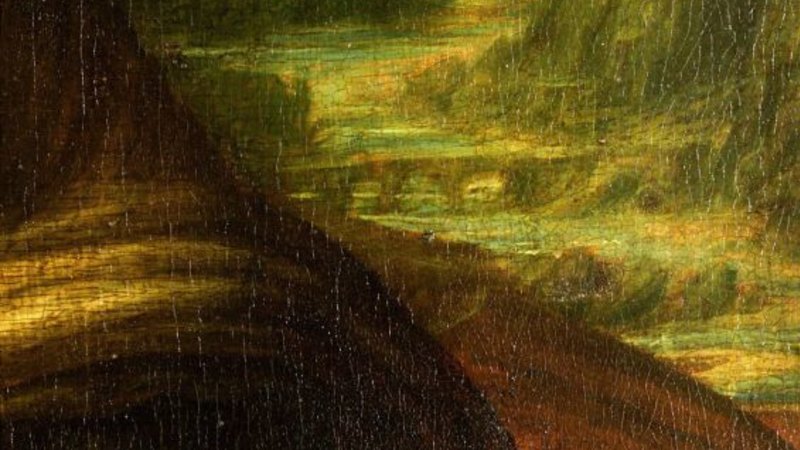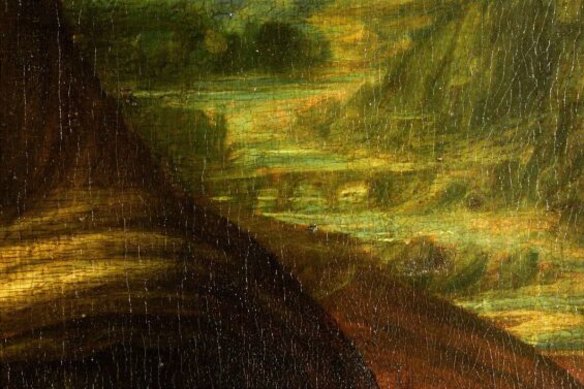Art historian says he has discovered the bridge in the Mona Lisa
Save articles for later
Add articles to your saved list and come back to them any time.
Rome: The mystery behind a stone bridge depicted in the Mona Lisa has finally been solved, after an art historian identified it as a crumbling ruin on the banks of a Tuscany river.
Drones and detective work were used to match the bridge featured in the background of Leonardo da Vinci’s painting to a real one spanning the Arno River near the village of Laterina.
The mystery behind a stone bridge depicted in the background of Leonardo da Vinci’s Mona Lisa has finally been solved.
All that remains of the Romito bridge today is a single arch, after it was badly damaged, probably by flooding, in the 18th century.
A digital reconstruction has shown it would have had four arches, just like the one in the portrait.
The Mona Lisa, a portrait of Lisa Gherardini, in the Louvre.Credit: Print Collector/Getty Images
On the opposite side of the riverbank, the foundations of what would have been the fourth arch can still be seen in the undergrowth.
The findings could transform the fortunes of tiny Laterina, where the bridge crosses the river Arno.
Simona Neri, the mayor, hopes the discovery – if confirmed – could encourage tourism.
The claim about the bridge was made by Silvano Vinceti, a historian who has written several books about Da Vinci. He found a document belonging to the Medici family in the state archives of Florence, which attests to the fact that the bridge at Laterina was intact and in frequent use when the painter was alive.
“We know he travelled through this part of Tuscany in the early 1500s – there is no doubt about that,” Vinceti, head of the Committee for the Enhancement of Historical, Cultural and Environmental Heritage, told a press conference in Rome.
The bridge was positioned on a road that connected Florence to the north with the busy market town of Arezzo in the south.
In the past, it was suggested that Da Vinci modelled the bridge in the painting on either a bridge near the village of Bobbio or another in Buriano, both in Tuscany.
But Vinceti pointed out that, as those bridges had more than four arches, they did not match the one in the painting.
They also spanned flat ground, whereas the Romito was built between two steep cliffs, corresponding closely to the bridge painted in the Mona Lisa.
The curve of the river in the painting also matched the curve of the Arno at the point where it was spanned by the bridge at Laterina.
“The bridge in the painting is neither the one at Bobbio nor Buriano. We’re convinced instead that it is the one at Laterina. We have all the elements that point to this being the bridge portrayed in the Mona Lisa,” Vinceti said.
He also dismissed suggestions that the bridge in the painting could have been a fictitious one, saying: “He was well known for drawing very realistically. The bridge is real. It was not conjured from his imagination.”
Using drones to survey the countryside, Vinceti believed he had identified the spot from where Da Vinci painted the bridge – a hill called Punta Caianello.
He also claimed to have identified the sheer-sided cliffs that appear on the left-hand side of the Mona Lisa.
They closely resemble a cluster of eroded, clay pinnacles that exist to this day in the upper valley of the Arno River, about 16 kilometres from the bridge at Laterina.
The idea that the bridge at Laterina could be the one painted by Da Vinci was first suggested by a local community association called La Rocca. Vinceti was brought in to investigate further.
Neri said: “There are plans for a hiking trail and bike path along the Arno River, so the bridge could be a key feature of that new route.
“We need to make sure the remaining arch is protected. It lies between two dams and at certain times of year there are very big flows of water on that stretch of the river.”
Neri expected friendly competition to develop with the two other villages that claimed to have the “real” Mona Lisa bridge
“Of course! This is Italy – we are famous for our campanilismo [parochialism].”
The Telegraph, London
Get a note direct from our foreign correspondents on what’s making headlines around the world. Sign up for the weekly What in the World newsletter here.
Most Viewed in World
From our partners
Source: Read Full Article



